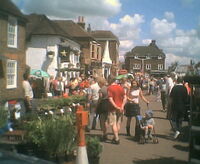< Malling Action Partnership, < MAP Social and community group

Farmers Market, West Malling, Kent, England, May
Photo credit:Philralph
Health check[]
Below are some broad conclusions based on MAP research. (see references re source data)
Local populations[]
- The town of West Malling's population represents only about a tenth of that of the whole study area (the town and hinterland parishes).
- The study area's population is dominated by the parishes to the east and south of the town - East Malling and Larkfield, Kings Hill, and Leybourne - which together comprise roughly three quarters of the total.
Retired population[]
Although for the study area as a whole the retired population is likely to be a smaller proportion of total poulation than regionally or nationally, areas within the study area are different.
- The parishes to the east and south of the town - East Malling and Larkfield, Kings Hill, and Leybourne - plus Mereworth and Birling are likely to have relatively low proportions of population over retirement age.
- the remaining smaller (in population terms) parishes to the West are likely to have relatively higher proportions of population over retirement age
- West Malling parish itself has the highest proportions (within the study area) - nealry one in four aged 65 or over, and a proportion 75 and over nearly twice the national figure.
Younger population[]
The study area as a whole shows a slightly higher proportion of under 16's than regionally or nationally. But again there are differences between groups of the parishes
- The parishes to the east and south of the town - East Malling and Larkfield, Kings Hill, and Leybourne - plus Mereworth have proportions higher than the regional average
- the remaining parishes, including West Malling, have slightly lower proportions than the regional average
Employed population[]
People in managerial and professional occupations: there's a marked contrast between the proportions for Kings Hill parish and those for East Malling and Larkfield and Mereworth. Kings Hill has relatively high proportions in managerial and professional occupations (and correspondingly relatively low proportions in lesser skilled occupations) whereas the reverse is the case for East Malling and Larkfield and Mereworth. (unclear as yet how the area as a whole compares with regional and national proportions)
Household population[]
The pattern for proportion of one person pensioner households mirrors that of the elderly population.
- West Malling parish has a higher (than the regional average) proportion of one person households, and its proportion of one person pensioner households - nearly a quarter of all households - is nearly twice that of the study area as a whole.
Population trends[]
(more info needed for example including changes at Kings Hill?)
References[]
- MAP research, based on Crown Copyright source data (not included here) - 2001 Census and more recent statisitics are available via Neighbourhood Statistics and the National Statistics website: www.statistics.gov.uk
Analysis[]
West Malling's population profiled compared[]
- West Malling parish is, in population terms, dominated by the adjacent built up parishes of the Medway Gap and the relatively close urban area of Maidstone to the east. This may have implications for the location of services now and in the future. Market towns which are more isolated are more naturally the place where services will be located. Within West Malling's locality some services may be centred instead in more populated areas, for example leisure facilites and Volunteer Bureau situated in East Malling and Larkfield.
- The high proportion of one person pensioner households in the town suggests mobility and access issues are likely to be important.
Population change[]
(more info needed for example including changes at Kings Hill and Leybourne Grange?)